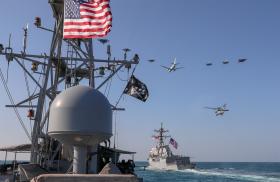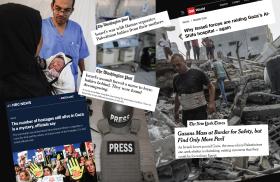The counterinsurgency in Iraq has entered a critical phase: the start of operations by U.S.-led coalition and Iraqi forces to pacify insurgent-held areas, smoothing the way for January 2005 elections. In recent weeks, coalition and Iraqi forces have battled insurgents in Tal Afar, Samarra, Mahmudiya, and Latifiya, as well as Sadr City and Haifa Street in Baghdad. They now appear to be preparing to move against Falluja, which has been described by some U.S. officials as the "center of gravity" of the Sunni insurgency.
The success of U.S. policy in Iraq will hinge on these operations, as well as on efforts to create strong and effective Iraqi Security Forces (ISF) to supplant coalition forces now engaged in counterinsurgency and stability and support operations. For this reason, recruiting, training, and equipping the ISF remains among the most important U.S. tasks in Iraq. Where do these efforts currently stand, and what are the prospects for their success?
Who's Who?
The ISF traces its origins to the various security organizations established by the Coalition Provisional Authority (CPA) following the dismantling of Saddam Hussein's police, security, and military forces. According to the Transitional Administrative Law adopted in March 2004, Prime Minister Ayad Allawi exercises ultimate authority over the ISF, though the U.S. embassy and Multinational Forces-Iraq (MNF-I) clearly have a large say in how it is employed. The main ISF organizations belong to the ministries of interior (MOI) and defense (MOD), although other ministries control smaller, specialized security forces (e.g., the oil security force, rail police, and electrical power security service).
Published U.S. government figures on the ISF are sometimes difficult to interpret; personnel and equipment tallies can be inconsistent, and counting rules and criteria for assessing training are often undefined. Nevertheless, it is possible to identify basic facts and trends. According to the most recently published U.S. government figures, the ISF consists of 106,266 "trained" personnel -- 57,726 in organizations belonging to the MOI and 48,540 in branches of the armed forces belonging to the MOD. Current plans call for Iraq to recruit and train a total of 272,729 security personnel.
MOI Forces
The Iraqi Police Service currently consists of 42,302 officers, with plans for a force of 135,000. The police are the first line of defense against criminals and insurgents and will be supported by several special police units now being created:
• The Emergency Response Unit is a national SWAT-type force that currently has seventy-six personnel, with plans to expand to 270. This unit will be responsible for activities such as high-risk arrests, hostage rescue, and explosive ordnance disposal.
• The Civil Intervention Force, currently being formed, is expected to consist of 4,920 personnel. It will provide a national-level, rapid-response capability to deal with insurgency-related violence and civil disturbances. This force will include nine approximately 400-man Public Order Battalions (i.e., riot police) dispersed throughout the country, as well as two approximately 800-man Special Police Regiments (a paramilitary gendarme-type force consisting of vetted former Iraqi special forces and General Security Directorate personnel equipped with heavy weapons and light armored vehicles; these regiments will act as a strike force and serve as the outer cordon during Emergency Response Unit operations).
Other MOI organizations will play lesser but still important roles in stabilizing Iraq:
• The Department of Border Enforcement currently has 14,313 personnel, with plans for a force of 32,000.
• The Highway Patrol has 589 officers, with plans for a force of 1,500.
• The Bureau of Dignitary Protection has 446 agents, with plans for a force of 500. This bureau will provide security for senior Iraqi officials.
• The Facilities Protection Service employs some 74,000 security guards at key facilities. They receive only six days of training, which may be why they are no longer included in U.S. government tallies of ISF strength.
MOD Forces
• The Iraqi National Guard (formerly the Iraqi Civil Defense Corps) conducts internal security operations in support of the police. It currently has 41,097 troops organized into forty-five battalions; this force will expand to sixty-five battalions organized into twenty-one brigade headquarters (at least one for each governorate) and six division headquarters (one for each MNF-I division in Iraq). Plans call for a total force of 61,904.
• The Iraqi Intervention Force, which currently consists of 1,743 troops organized into three battalions, will eventually expand to nine battalions organized into three brigades, with 6,584 troops. It will serve as the army's primary counterinsurgency force and will be capable of rapidly deploying to hot spots throughout the country in support of the National Guard. The force consists of volunteers who complete eight weeks of basic training and six weeks of special training in urban operations.
• The Iraqi Special Operations Force currently has 617 troops, with plans for the eventual creation of a Special Operations Brigade consisting of 1,967 troops. The force includes a battalion-size Counterterrorism Force and a Commando Battalion (formerly the 36th Iraqi Civil Defense Corps battalion, elements of which distinguished themselves in Falluja in April 2004).
• The regular Iraqi army has 4,507 troops organized into three battalions. By the end of January 2005, it is expected to have 27,000 troops organized into fifteen battalions (including one armored battalion) that will form the basis of two light infantry divisions (the 3rd and 5th). Additional plans exist to create a total force of 50,000 troops organized into six divisions.
• The Iraqi air force consists of 167 personnel, with plans for 502. Its inventory includes two new SB7L-360 Seeker two-seat reconnaissance aircraft for infrastructure and border security tasks -- the nucleus of the newly created 70th Aerial Reconnaissance Squadron (which will acquire between eight and sixteen additional two-seat SAMA CH2000 reconnaissance aircraft in the future). The inventory also includes two C-130 transport aircraft (the nucleus of an air transport squadron) and six UH-1 helicopters (with ten more on the way), which will serve as the nucleus of a helicopter squadron.
• The Iraqi Coastal Defense Force has 409 personnel, with plans for 582. It will include a coastal defense regiment and a patrol boat squadron with five 27-meter patrol boats.
Lessons Learned
The concept for training and employing the ISF was heavily influenced by the overall poor performance exhibited by many ISF units and personnel during the siege of Falluja and the Muqtada al-Sadr uprising in April 2004. Since then, the ISF has been reorganized in order to rectify critical shortcomings exposed during the fighting and to better reflect the national security concept of the Iraqi Interim Government. Among these shortcomings were the following:
• Recruits had not been effectively vetted; some ISF organizations (particularly the police and Civil Defense Corps) included numerous criminals and insurgent sympathizers in their ranks.
• Local recruitment and basing of police and security forces (particularly the police and Civil Defense Corps) made the recruits and their families vulnerable to pressure and threats, resulting in mass desertions and defections to the insurgency.
• Inadequate training and equipment (even when compared to that of the insurgents) sapped Iraqi morale and undermined trust and confidence between Iraqi and coalition forces.
• Inadequate attention was paid to the selection and training of leaders, hindering the effectiveness of the ISF at every level.
• Many ISF units lacked cohesion, disintegrating under the stress of potential and actual combat.
• Many ISF personnel refused to carry out orders from U.S. officers, insisting that they would take orders only from Iraqi commanders or political authorities.
Since April 2004, the coalition has worked to rectify these shortcomings by more thoroughly vetting ISF personnel; by taking initial steps toward recruiting and basing ISF units on a regional basis in order to reduce the susceptibility of ISF personnel and family members to insurgent threats and intimidation; by improving the quality of equipment and training; by placing greater emphasis on team-building as well as the selection and training of quality leaders; and by creating a parallel Iraqi chain of command to oversee the employment of the ISF.
It is not clear to what extent these problems have been resolved. The ISF apparently still harbors petty criminals, corrupt individuals, and insurgents -- a problem exacerbated by the rehabilitation and recruitment of former Baathists. Iraqis still complain of police corruption, and several senior army and National Guard officers have been dismissed or arrested for suspected ties to insurgents (including the former chief of staff of the armed forces, dismissed in June 2004). The police and National Guard still recruit locally -- an unavoidable practice in rural and semirural areas; consequently, ISF personnel remain vulnerable to threats and intimidation. Moreover, efforts to equip and train the ISF still lag in some areas, although the situation is gradually improving.
On this point, U.S. government statistics published in late September 2004 are revealing. They show that in terms of training and equipment, the army's small Special Operations Force was best off: 90 percent of its personnel were trained, 95 percent had body armor, and the force had sufficient arms on hand for all assigned personnel. The police, regular army, and National Guard occupied a middle ground. Some 40 percent of police and regular army personnel were trained, along with 95 percent of National Guardsmen, though for most this meant attending abbreviated basic or transition courses. Fifty percent had body armor, and while all three organizations had enough weapons for all assigned personnel, they were frequently outgunned by insurgents armed with machine guns, rocket-propelled grenades, and mortars. The Iraqi Intervention Force was least well off: only 25 percent of its personnel were considered trained; 40 percent had body armor, and there were weapons on hand for only 45 percent of its personnel.
Since April, in addition to continuing the practice of pairing U.S. and ISF units, U.S. special forces teams have been embedded with Iraqi units in order to mentor, build teamwork, and bolster their confidence. U.S. forces have generally taken the lead in joint operations, spearheading attacks and assuming the more tactically demanding tasks. Iraqi forces generally serve in a follow-on and support role, seizing culturally sensitive sites used by insurgents (e.g., mosques). Whenever feasible, however, Iraqi forces have been encouraged to take the lead, and their role in joint operations is likely to increase as they gain experience.
Finally, due to the worsening security situation, the Iraqi Interim Government has evinced a greater willingness than its predecessors (the CPA and the Iraqi Governing Council) to use the Iraqi army for internal security tasks. Although it is born of necessity, this move nevertheless entails risks: in the 1930s and 1960s, the army's role in internal security led to its politicization and eventual involvement in repression and coup-plotting.
Michael Eisenstadt is a senior fellow and director of the Security Studies Program at The Washington Institute.
Policy #910



